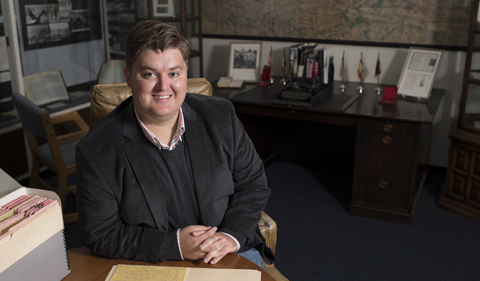From Perspectives
When history enthusiast Seth Givens was an Ohio University undergraduate student, he discovered a unique collection of materials that features raw, unpolished military and civilian personal accounts of World War II. Only about 10 percent had ever been published.
The Ohio University Libraries’ Cornelius Ryan Collection includes about 21,000 primary sources that the war correspondent-turned-author had gathered while writing several books about World War II, including The Longest Day, a best-selling account of D-Day.
When the time came for Givens to write his master’s thesis, he mined the collection for accounts of wartime souvenir hunting and looting. The U.S. military condones the former and prohibits the latter, but prior research often grouped the acts together.
Givens, however, found the behaviors in World War II to be two very different things. Souvenir hunting occurred when GIs collected commonplace items from battlefields as tokens to take home. Looting—the pillage of civilian possessions—was decidedly more problematic. Givens discovered that looting by American GIs increased dramatically as they moved deeper into Germany in 1945. It became so ubiquitous that soldiers gave it a tongue-in-cheek name: “liberating.”
“The American serviceman who restrained himself from stealing in Allied countries saw looting in Germany as morally and legally justifiable,” Givens says.
Upon examining the collection, Givens discovered four reoccurring justifications for the behaviors: wartime necessity, opportunity for trade or profit, personal remembrance, and revenge. He deduced that the rise of looting in Germany was linked to desires for retribution.
“This stealing for revenge was meant to convince die-hard Nazis they truly were defeated, and to mete out justice to those Germans who were associated with prison, labor, or extermination camps,” he says.
Givens’ study made waves in the world of military history, as American GIs’ proclivity for looting in World War II was often glossed over or ignored. The peer-reviewed academic journal War in History published the research in January, and adaptations of his thesis garnered Best Paper awards at the Northern Great Plains History Conference and the history-oriented James A. Barnes Club Conference at Temple University.
Givens now plans to revisit the Cornelius Ryan Collection for his doctoral dissertation, currently titled “Cold War Capital: The United States and the Fight for Berlin, 1945-1994.” Ryan had a penchant for capturing fresh responses from soldiers, and the research value of that is not lost on Givens.
“What generally happens when soldiers remember things is that they have stock answers and stock stories to tell people,” Givens explains.
Realizing that respondents couldn’t give rote responses to questions they’d never been asked before, Ryan made inquiries like: “What was the funniest thing that happened on D-Day?”
The tactic worked well. According to Givens, the question caught respondents off guard, made them think, and yielded a large portion of the collection’s accounts of looting and souvenir hunting.
And what was the funniest thing that happened on D-Day?
“Not very many things,” Givens says, smiling, “but you’d be amazed.”
Story by Jen Doyle, Ohio University Libraries
This story will appears in the Spring/Summer 2014 issue of Ohio University’s Perspectives magazine, which covers research, scholarship and creative activity.



















Comments